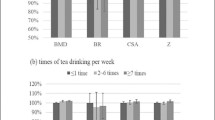Abstract
Aim
Vitamin D deficiency is one of the most important risk factors in the development of osteoporosis. Recently, vitamin D deficiency is more frequently encountered than expected in Mediterranean countries, which are sunny most of the time. Our country is one of these sunny countries and here, we investigated the effect of outfitting style on bone mineral density (BMD) and plasma vitamin D levels in women aged between 30–40 years.
Method
Eighty women, aged between 30 and 40 years, were included in the study. They were divided into two groups, depending on their dress selection. Group-1 consisted of 40 cases with an open clothing style, while the 40 women in group-2, preferred the covered clothing style. Women were questioned in terms of the risk factors for osteoporosis. Levels of plasma 25(OH)2 vitamin D3 and parathormone (PTH) were tested along with routine blood analyses. BMD of Lumbar 1–4, femur neck, trochanter, and Ward’s triangle were measured.
Results
In group-2, number of pregnancies and body mass index (BMI) was statistically significantly higher (p < 0.05). When the laboratory parameters were compared, in group-2, only levels of plasma 25 (OH)2 vitamin D3 was significantly lower than group-1 (p < 0.05). There was no significant difference among groups in terms of BMD. In group-2, there was a positive correlation between BMI and BMD at L1–4, hip, femur neck, and trochanter regions (p < 0.01, 0.01, 0.05, and 0.05, respectively).
Conclusion
Traditional clothing style leads to vitamin D deficiency in women. In order to meet vitamin D need, the face, arm and leg regions of the body should be exposed to one minimal erythemal dose (MED; i.e., slight redness of the skin) of sunlight, at least two or three times a week. We believe that these cases should be more closely monitored for bone loss, especially during postmenopausal period, which is considered as a risky term in terms of osteoporosis development.
Similar content being viewed by others
References
NIH Consensus development panel on osteoporosis prevention, diagnosis and therapy (2001) JAMA 285:785–795
Holick MF (2003) Vitamin D: a millenium perspective. J Cell Biochem 88:296–307
Holick MF (2003) Evolution and function of vitamin D. Recent Results Cancer Res 164:3–28
Brot C, Vestergaard P, Kolthoff N et al (2001) Vitamin D status and its adequacy in healthy Danish perimenopausal women: relationships to dietary intake, sun exposure and serum parathyroid hormone. Br J Nutr 86:97–103
Mac Laughlin J, Holick MF (1985) Aging decreases the capacity of human skin to produce vitamin D3. J Clin Invest 76:1536–1538
Pettifor JM, Moodley GP, Hogh FG et al (1996) The effect of season and latitude on invitro vitamin D formation by sunlight in South Africa. S Afr Med J 86:1270–1272
Need AG, Morris HA, Horowitz M (1993) Effects of skin thickness, age, body fat, and sunlight on serum 25-hydroxyvitamin D. Am J Clin Nutr 58:882–885
Reid IR, Gallagher DJA, Bosworth J (1985) Prophylaxis against vitamin D deficiency in the elderly by regular sunlight exposure. Age Ageing 15:35–40
Sedrani SH, Elidrissy AW, El Arabi KM (1983) Sunlight and vitamin D status in Saudi subjects. Am J Clin Nutr 38:129–132
Fonseca V, Tongia R, El-Hazmi M et al (1984) Exposure to sunlight and vitamin D deficiency in Saudi Arabian women. Postgrad Med J 60:589–591
El-Sonbaty MR, Naser UAMA Abdul-Ghaffar (1996) Vitamin D deficiency in veiled Kuwaiti women. Eur J Clin Nutr 50:315–318
Alagöl F, Shihadeh Y, Boztepe H et al (2000) Sunlight exposure and vitamin D deficiency in Turkish women. J Endocrinol Invest 23:173–177
Gannage-Yared MH, Chemali R, Yaacoub N (2000) Hypovitaminosis D in a sunny country: relation to lifestyle and bone markers. J Bone Miner Res 15:1856–1862
Grover SR, Morley R (2001) Vitamin D deficiency in veiled or dark skinned pregnant women. Med J Aust 175(5):251–252
Amling M, Priemel M, Holzman T et al (1999) Rescue of the skeletal phenotype of vitamin D reseptor-ablated mice in the setting of normal mineral ion homeostasis: formal histomorphometric and biomechanical analyses. Endocrinology 140:4982–4987
Gallagher JC, Kinyamu HK, Fowler SE et al (1998) Calciotropic hormones and bone markers in the elderly. J Bone Miner Res 13:475–482
Ooms ME, Roos JC, Bezemer PD et al (1995) Prevention of bone loss by vitamin D supplementation in elderly women. J Clin Endocrinol Metab 80:1052–1058
Dawson-Hughes B, Dallal GE, Krall EA et al (1991) Effect of vitamin D supplementation on wintertime and overall bone loss in healthy postmenopausal women. Ann Intern Med 115:505–512
Taha W, Chin D, Silverberg A et al (2001) Reduced spinal bone mineral density in adolescents of an Ultra-Orthodox Jewish Community in Brooklyn. Pediatrics 107:1–6
Ghannam NN, Hammani MM, Backheet SM et al (1999) Bone mineral density of the spine and femur in healthy Saudi females: relation to vitamin D status, pregnancy, and lactation. Calcif Tissue Int 65:23–28
Wortsman J, Matsuoka LY, Chen TC et al (2000) Decreased bioavilability of vitamin D in obesity. Am J Clin Nutr 72:690–693
Liel Y, Edwars J, Shary J et al (1988) The effects of race and body habitus on bone mineral density of the radius, hip and spine in premenopausal women. J Clin Endocrinol Metab 66:1247–1250
Van Bersteijin ECH, van’t Hof MA, de Waard H et al (1990) Relation of axial bone mass to habitual calcium intake and to cortical bone loss in healthy early postmenopausal women. Bone 11:7–13
Ribot C, Tremollieres F, Pouilles JM et al (1988) Obesity and postmenopausal bone loss: the influence of obesity on vertebral density and bone turnover in postmenopausal women. Bone 8:327–331
Author information
Authors and Affiliations
Corresponding author
Rights and permissions
About this article
Cite this article
Güler, T., Sivas, F., Başkan, B.M. et al. The effect of outfitting style on bone mineral density. Rheumatol Int 27, 723–727 (2007). https://doi.org/10.1007/s00296-006-0297-y
Received:
Accepted:
Published:
Issue Date:
DOI: https://doi.org/10.1007/s00296-006-0297-y




